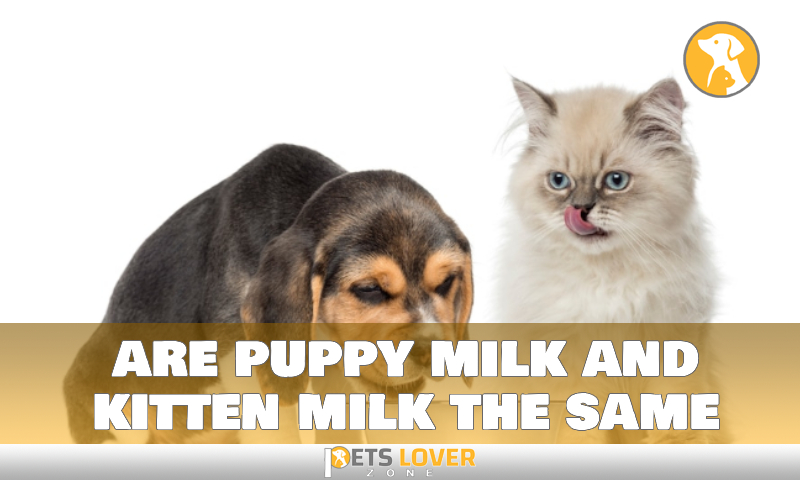Do you ever wonder if puppy milk and kitten milk are the same? It’s an age-old question that seems to have no definitive answer. We know that milk is essential for puppies and kittens, but there’s a lot of confusion about whether or not they need the same type of milk.
This blog post is here to set the record straight and dispel any confusion. We will compare the nutritional content of both types of milk, explore their differences, and provide advice on how you can ensure your pets get the best nutrition.
So, let’s dive in and answer this age-old debate once and for all: Are puppy milk and kitten milk really the same?
Milk for Puppies and Kittens: The Basics
It’s a common myth that puppies and kittens can have the same milk. In fact, that couldn’t be further from the truth. Both pets require special milk replacement formula to ensure adequate nutrition and health benefits.
Kittens should be fed no more than a tablespoon of milk replacement every 2-3 hours until they are eight weeks old. Kitten formula should be used rather than regular cow’s milk, as it contains higher levels of calcium, proteins, and other nutrients required for their proper development. Kittens should never be given milk until they are two weeks old.
Puppies, on the other hand, can begin consuming puppy formula right away at birth as long as they nurse well after each feeding. Puppy formula is also essential for their growth and health, as it provides them with the additional calories and nutrients they need while they are growing and developing. For convenience, ready-made puppy formulas can be purchased at most pet stores or online retailers.
Nutritional Requirements: Puppies vs Kittens

One of the biggest differences between puppies and kittens is their nutritional requirements.
Kittens have a much higher requirement for both protein and essential amino acids like arginine, lysine, and methionine. Kitten milk typically has up to 30-36% of its metabolic energy supplied by protein, compared to 25-29% for puppy milk. This is because kittens need higher levels of protein and essential amino acids compared to adult cats, as well as puppies.
For example, arginine is important for growth in kittens but not so much in puppies. So if you are considering either one for your pet, it’s important to factor in their individual nutritional differences. Kitten milk may provide more nutrients needed by growing cats than puppy milk would.
Ingredients: Are Puppy and Kitten Formulas Identical?
When it comes to ingredients, puppy milk, and kitten milk are not the same. Kitten milk contains a higher percentage of fat and protein than puppy milk, making it more nutritious for the growing bodies of newborn kittens. Additionally, kitten formulas contain all the necessary ingredients kittens need to grow healthy and strong. This includes taurine, an essential amino acid that cats can’t produce on their own. Puppy formulas don’t have this essential ingredient.
That said, both puppy formula and kitten formula are complete diets, provided they are given in appropriate amounts. Goat milk is even more important than just good nutrition for newborn kittens and puppies – its beneficial bacterial cultures aid in digestion and help protect their immune systems from disease. Therefore, it’s a great idea to supplement a balanced diet with goat’s milk starting at three weeks of age for both puppies and kittens.
Feeding Guidelines: How Much and How Often?
The amount and frequency of feedings for kittens and puppies depend on their age and breed. Generally, kittens and puppies should consume two tablespoons of formula per four ounces of body weight every three to four hours.
Kittens, however, can be fed fewer times in a day. When they reach two weeks old, two meals a day should suffice. As they get older, you can reduce the number of meals to one to three times a day – as long as it does not exceed their total daily calorie needs.
Puppies require more frequent feeding; until their 12th week, you should feed them three to four meals per day. After that, reduce it to two or three meals per day until they reach six months old. At that point, you can switch them to an adult dog diet with one or two vet-specified meals per day.
Knowing how much and how often to feed your pet is essential for its health and growth into adulthood – so pay attention to the details!
Weaning Puppies and Kittens: When to Switch to Solid Food
When it comes to weaning puppies and kittens, the process should start at 4 weeks. They should be fully weaned and eating solid food within 6-8 weeks. It’s important to note that the transition from kitten milk or puppy milk to solid food won’t happen overnight – your furry friends will need both patience and a little bit of help as they adjust.
Kittens are especially prone to digestive issues when introduced to solid food, so up until about 8 weeks of age, it’s important to keep a significant amount of water in their diet. As they mature, you can gradually reduce the amount of water as they become more comfortable with the new food.
To ensure that you’re giving your kittens and puppies the nutrition they need, be sure to select all-natural ingredients that are free from preservatives and artificial flavoring, tailored to their growth stage. This will help them make a smooth transition, giving them all the nourishment they need at each stage of life.
Are Puppy Milk Replacements and Kitten Milk Replacements Interchangeable?
The short answer is no. Kitten milk and puppy milk replacements have different compositions and are not interchangeable. Kitten milk has a higher fat and protein content than puppy milk, which has higher concentrations of lactose. This ensures the body chemistry of each species is catered to in the most appropriate way possible.
In fact, raw goat’s milk does not provide the same protein and fat content as puppy or kitten milk substitutes, making it unsafe for either species when used as a substitute for formula. Therefore, it’s important to ensure you make use of specialized formulas that are specifically designed to meet their nutritional needs.
Other Ingredients: What’s Added and Why It Matters
When it comes to puppy milk and kitten milk, the answer is not as simple as you might think. While the base ingredient of these products is evaporated milk, there are additional ingredients that can make all the difference in the health and nutrition of these young animals.
Protein, Calcium & Vitamin D
Evaporated milk is high in phosphorus, potassium, magnesium, sodium, and selenium, making it an essential source of nutrients needed for healthy bones. It also provides protein and calcium, as well as vitamin D, which helps puppies and kittens absorb calcium more efficiently.
Other Ingredients
There are other ingredients added to these products to stabilize liquids, such as non-dairy creamers. These include emulsifiers to help prevent the separation of fats and other components in the liquid; preservatives like sodium benzoate; stabilizers like carrageenan; and thickening agents like xanthan gum. All of these ingredients provide additional benefits for puppies and kittens by helping them absorb all the nutrition they need for growth and development.
What About Other Baby Animal Milks?

You might think that puppy milk and kitten milk are all the same, but in fact, other animals also produce milk for their young. Goats, sheep, buffaloes, camels, giraffes, mares, zebras, reindeer, and yaks are all milk producers.
But while these milks may seem similar to one another on the surface, they still have differences when it comes to nutrient composition. Animal milk products do not provide a complete nutritional source for infants – cow milk and goat milk both have very different nutrient profiles compared to human milk – meaning that puppies and kittens still have unique nutritional needs.
When considering different animal milks for a puppy’s or kitten’s nutrition plan, it is important to research the specific nutrients provided by each type of animal milk to ensure they are getting the best possible start in life.
When Is It Safe to Switch From Replacer Milk to Regular Food?
When considering the differences between puppy milk and kitten milk, it is important to remember that kittens should not be fed regular food until they are weaned. The transition to solid food should take place as part of the weaning process.
In general, kittens should begin eating solids at four weeks of age, with full weaning achieved by eight weeks. During this time, commercial kitten milk replacers (KMR) should be used to bottle feed them until they are eating primarily solid food. KMR is specially designed for kittens and is certified for pregnant and nursing cats.
Puppies, on the other hand, require more frequent feedings and should be fed canned or commercial pet food containing milk replacer until weaned. Puppies usually start eating solids three to four weeks after birth and are completely weaned by seven to eight weeks.
No matter whether you have kittens or puppies, you can rest assured that there is a medically approved solution for feeding them from infancy until adulthood.
Our Recommendations: The Best Puppy and Kitten Milk Formulas
At this point, it’s clear that kitten milk and puppy milk are not the same and thus should not be used interchangeably. So what type of milk do you need for your pet?
For kittens, as mentioned before, it’s best to opt for a formula that contains a higher fat and protein content than puppy milk. Look for products that are specifically formulated for kittens, such as those that contain additional vitamins, minerals, antioxidants, and taurine.
For puppies, there are numerous types of puppy milk replacements that can provide the necessary protein and fat content to support healthy growth. Bear in mind that puppies require much more nutrition than adult dogs, so take time to research the best formulas available to ensure your pup gets the nourishment they need.
Conclusion
Although both puppy milk and kitten milk share similar characteristics and are both necessary for proper nutrition and development, there are some notable differences between the two. Puppy milk is more energy-rich and contains higher concentrations of certain nutrients, while kitten milk contains higher levels of certain fatty acids and proteins. Ultimately, both kinds of milk are important for the proper health and development of puppies and kittens; however, they should not be treated as interchangeable. Owners should seek qualified veterinary advice when deciding which type of milk is best for their pet, and how to properly feed them.






